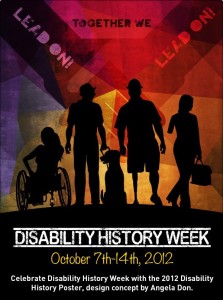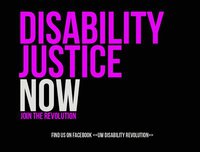The Imperative to Be Abled: The ReWalk Exoskeleton
In his 2011 book Disability Theory, Tobin Siebers discusses the ableist cultural expectation that disabled people should be as able-bodied as possible. Nondisabled people, Siebers notes, are allowed to use an array of labor-saving devices, even when they are physically able to complete their tasks without them. When disabled people want to use devices to increase the quality of their lives, however, these devices are considered a drain on social resources and an unnecessary form of assistance. So while able-bodied people are encouraged to reduce their labor by means of such devices as washing machines and leaf blowers, disabled people are met with resistance when lobbying for ramps and elevators. In short, disabled people are expected to “maintain the maximum standard of physical performance at every moment” and “always present as able-bodied as possible.” (Siebers 2011, 31-32)
The imperative to be able-bodied is ever-present. Well before I was diagnosed with the disabilities I’ve had all my life, it was my mission to be super-able at all times. For reasons I didn’t understand then — but that are very clear to me now — I always felt the need to prove how high achieving I could be, and how far above expectations I could soar. As one of my more insightful managers once said to me, “You only work at normal human speed when you’ve got the flu.” He wasn’t joking. I should have taken that as permission to slow down. I didn’t. And while I take better care of myself now, rest when I need to, and set reasonable expectations for my body, I still find it difficult to not exceed expectations. The habit is both deeply ingrained and constantly reinforced from the outside.
I’m always of two minds about the levels to which I push myself. On the one hand, I like challenging myself, physically and intellectually. On the other hand, I’m not sure that I always like where the impulse comes from. All too often, I’m aware that I feel I’ve got something to prove.
So it was with a pang of recognition that I read a MailOnline story about a woman named Claire Lomas who, this past May, walked the London Marathon wearing a ReWalk exoskeleton. Ms. Lomas had been an accomplished horsewoman before she was thrown from a horse in a riding competition and became paralyzed from the chest down. The ReWalk device enabled her to stand upright and to walk, with arm crutches, the entire 26 miles, over the course of 16 days.
Now, I make it a point to refrain from advising disabled people on how to live their lives, and I don’t feel a particular need to judge whether or not it was a good idea for Ms. Lomas to walk the marathon route. If she felt that walking 26 miles in an exoskeleton was a feat she wanted to accomplish, I feel inclined to support her, although I’m unhappy that she did it to raise money for a cure that may never come, rather than for services to support disabled people in the here and now. For the purposes of this piece, though, what concerns me is not what Claire Lomas the Athlete did, but the way in which Claire Lomas the Story is being written. I’m deeply troubled by the way in which her story has been spun, and by the way in which the ReWalk device is being hailed as the solution for what ails disabled people.
Some of the verbiage in the MailOnline article is rather astonishing in its praise for Ms. Lomas’ accomplishment. The word “heroism” appears twice, and the word “heroic” once. She “conquered” the course, the article crows, after being “liberated from a wheelchair.” (Harris and Thornhill 2012) I’m used to hyperbole from MailOnline, but even the more moderate news outlets couldn’t help but gush. For example, note the way in which an ABC News article describes the feelings of the crowd that had gathered to cheer on Ms. Lomas on her final day of walking:
But they all were there for her, inspired by her determination to finish the race, inspired by her becoming the first woman in a robotic suit to complete a marathon, inspired by her ability to, as she told ABC News today, “just keep persevering.” (Shifrin 2012)
It’s simply not possible, it seems, to cover the accomplishments of disabled athletes without using a variation on the word inspire. But all of this terminology really begs the question: What is so heroic about walking 26 miles over the course of 16 days? What precisely has Ms. Lomas conquered? Why is she considered so inspiring? And how is it liberating to wear a seven-pound suit that enables you to walk between one and two-and-a-half miles a day, only to leave you “aching with pain” and “struggling to stay upright”? (Harris and Thornhill 2012)
The answer: To the able-bodied public, Ms. Lomas heroically battled against her disability and conquered it. She stood upright and walked. She didn’t use a wheelchair, the universal symbol of disability. She became as able-bodied as possible. And for this feat, accolades have poured in from all over the world, and people have considered themselves inspired.
After reading about Ms. Lomas, I decided to find out more about the ReWalk exoskeleton and how it’s being addressed in the media. What I found were sentiments mired in entirely uncritiqued attitudes about disability. For example, let’s look at a March 12, 2011 article in The Economist under the following headline:
The right trousers
Robotics: An artificial exoskeleton, akin to a pair of robotic trousers, promises to bring hope and dignity to paraplegics by letting them walk (The Economist 2012)
Or, to put it somewhat more directly: If you can’t walk on two legs, you are shameful and hopeless. If you think the article gets worse from there, you’re entirely correct. It begins:
CONFINEMENT to a wheelchair is not merely frustrating and degrading. It is positively bad for the health. People confined to wheelchairs often suffer urinary, respiratory, cardiovascular and digestive-system problems, as well as osteoporosis and pressure sores (The Economist 2012).
Note the use of the word “confinement” — a term altogether in contradiction to the experience of millions of wheelchair users who report that a wheelchair liberates them by giving them mobility. Note the appalling idea that using a wheelchair is “frustrating” and “degrading.” Why should sitting in a chair with wheels that brings you from one place to another be frustrating and degrading? The reason: It is a sign of disability. It is a sign of not being as able as possible. It is a sign, according to the writer, of a host of devastating physical problems to which the ReWalk suit is the answer.
The idea that walking around with a seven-pound ReWalk system is healthier for your body than using a wheelchair is wishful thinking, to use the kindest phrase I can summon. Given that the ReWalk device hasn’t been used by very many people for very long, there is absolutely no evidence to support this idea. But of course, the issue isn’t whether the device is actually healthier. The issue is that the device is being hawked to make people appear healthier — that is, without disability. Note the way in which it is being marketed by its creator, Eric Goffer:
Dr. Goffer says his aim is to enable paralysed people to lead normal lives. As well as giving users the ability to walk, the device also helps them regain their dignity (The Economist 2012).
So, all you have to do is wear a bionic suit, and you will live a “normal” life (whatever that means) and walk (literally) in the light of dignity. I’m not sure how this sort of magic works, especially given the fact that no one is going to overlook the presence of a bionic suit and arm crutches when assessing whether a person is “normal” and thereby worthy of respect, employment, housing, services, companionship, and basic human rights. But from the perspective of the writer, the simple act of walking gives one dignity, while the simple act of sitting robs one of it. Who knew it was that easy?
In order to maintain this mythology, the imperative to be as able as possible is placed firmly on the back of the disabled person. Able-bodied people needn’t bother themselves to help, as the writer makes abundantly clear:
When someone is in a wheelchair his head is at the height of an average person’s waist. This literal diminution of his stature can reduce his metaphorical stature, too. Once able to stand up, his stature, in both senses of the word, is restored—and that can be just as valuable as the health and mobility benefits (The Economist 2012).
In other words, under no circumstances could able-bodied people be expected to expend the effort required to use their able bodies to sit down and be at eye level with a person in a wheelchair. No. Perish the thought. Instead, a person who is paralyzed has to wear a $120,000 bionic suit in order to stand up. Could the imperative to be as able-bodied as possible be any clearer?
I worry about these kinds of articles, for a host of reasons, not the least of which is that people who could benefit from the mobility a wheelchair offers simply refuse to use one because they have been made to feel ashamed. Along these lines, Dave Hingsburger recently wrote about a conversation he had with a woman who said that her aging mother was too proud to use a wheelchair, and that she admired her mother’s attitude — despite the fact that the woman’s “pride” was rendering her housebound. Dave’s response was a reminder of the way in which the imperative to be able-bodied can hold us prisoner:
I suggested to her that maybe the fact that people admire her for clinging to non-disabled status is what keeps her clinging to non-disabled status. Maybe the idea that using a wheelchair involves a loss of pride rather than a gain of mobility is what keeps people shut in. (Hingsburger 2012)
The adulation over the ReWalk device is just one example of the public shaming of people with disabilities, and it has significant consequences. People would rather be shut in than be seen in public in a wheelchair. People would rather live in fear and self-hatred than become a visible part of the disability community.
The only alternative to this kind of shaming is pride. As Dave Hingsburger says so eloquently:
We need disability pride because people seem to assume we live with disability shame (Hingsburger 2012).
Indeed.
References
The Economist. “The Right Trousers.” http://www.economist.com/node/18304226. March 10, 2011. Accessed June 6, 2012.
Harris, Paul and Ted Thornhill. “Give Claire a medal! Tim Henman leads calls for organisers to reward paralysed marathon ace who finished Marathon in 16 days… as she raises £130,000 for charity.” MailOnline, May 10, 2012. Accessed June 6, 2012. http://www.dailymail.co.uk/news/article-2141302/Claire-Lomas-Paralysed-woman-completes-London-Marathon-bionic-suit.html.
ReWalk Bionics Research. http://rewalk.us/about-2/. Accessed June 6, 2012.
Rolling Around In My Head. “Throne of Shame.” http://davehingsburger.blogspot.com/2012/06/throne-of-shame.html. June 7, 2012. Accessed June 7, 2012.
Shifrin, Nick. “Paralyzed Woman Finishes London Marathon.” ABC News, May 8, 2012. Accessed June 8, 2012. http://abcnews.go.com/International/paralyzed-woman-finishes-london-marathon/story?id=16304503#.T9I447UdM9B.
Siebers, Tobin. Disability Theory. Ann Arbor, MI: University of Michigan Press, 2011.
© 2012 by Rachel Cohen-Rottenberg









GirlWithTheCane
6/9/2012 | 6:48 am Permalink
I hear “confined to wheelchair” and “wheelchair-bound” much more than I’d expect to these days. It always catches me by surprise when I do, because it seems like in this day and age people should know better. But there’s obviously still a lot of work to do, changing attitudes about people with disabilities…. getting people to see that disability is really a social construct and that the biggest barriers to true equality are in our minds.
Great article.
Niksmom
6/9/2012 | 9:07 am Permalink
Another fantastic piece, Rachel. Thank you, thank you, thank you!
Dave Hingsburger
6/9/2012 | 2:27 pm Permalink
A wonderful piece, I’d had all sorts of conflicting reactions to ReWalk and simply haven’t managed to put anything down on paper. Now I don’t need to, you’ve said it all here. I am honoured to be quoted in a piece like this.
Moose
6/10/2012 | 1:32 am Permalink
The concept that disabled people need to be “just like ‘normal’ people” is so pervasive in our society it’s depressing.
Recently I saw a video of a disabled person who goes around giving talks about how he can do anything he sets his mind to, doesn’t let his disabilities stop him, blah blah blah, we’ve all heard it before.
Someone commented that disabled people do not exist to make able-bodied people feel better about their lives as they try to live a life that other people would call “normal.” This comment got a storm of “How dare you!” type responses. “Maybe what he says helps other people to understand that their little problems are unimportant!” was the general response.
The ableism in this is overwhelming. First of all, there’s the problem of “The exception is not the rule.” The media loves stores about those who “Beat the odds!” and society starts wondering why everyone isn’t like that. As a disabled person, I’m sure you’ve had some able-bodied person explain to you that they saw a story about someone just like you who (fill in the blank — was able to walk again, went on a thousand mile solo hike, sailed around the universe, whatever), and – here’s the kicker — They Did It, So Can You.
(As a fat disabled person I’m constantly being told that if I just lost weight, I’d be able to walk again. If I’m in an especially bad mood, I will explain to these nitwits how they should return their medical degree to the Cracker Jack Box it clearly came from.)
So once you have the “The Exception Did It, So Can You” mindset you get people wondering why extra things have to be done to help the disabled. Recently I read complaints about pools being shut down because they did not have accessible access, which was required by a particular date. The most common comment went along the lines of, “Well it’s just wasted expense, there’s so few disabled people that all that money is going for just a very few people, just like our tax dollars get wasted on kerb cuts and cross-walk signs that beep.”
I totter back and forth between rage at the selfishness and weeping for a humanity that seems to have lost any compassion it might have once had. (Unless it’s compassion for someone who is disabled who shows how able-bodied they can be.)
Katharine Annear
6/10/2012 | 5:58 am Permalink
I wonder how the headline “Cyborg Completes Marathon” would have gone down.
claire donnelly
6/10/2012 | 5:05 pm Permalink
Only discovered your blog Rachel today and it is already my fave. As Australia battles its ignorance and prejudice
in an attempt to provide a National disability insurance scheme (NDIS) the catchcry of the majority is one of “why should I pay for their luxuries”. A luxury I assume is something as simple as my desire to have more than 2 showers a week! We are assumed to be living life ‘high on the hog’ on the largesse of the public purse…..
Demands for us to ‘get a job’ when no one will offer us one even when we are more than willing…..
sigh…..
mary
6/10/2012 | 5:19 pm Permalink
Like so much in the modern world, it’s style over content, form over function. Better to “walk” 2 miles in a suit costing 120,000 and be sore and exhausted at the end of it, than to roll 4 miles in a wheelchair costing 4,000 and be feeling comfortable enough to participate in life at your destination. I think part of it is also the novelty – I’d quite like a go in one of these suits in the same way as I’d quite like to fly in a hot air balloon, it would be an interesting and unique experience but hardly a way to go to the shops or pick the kids up from school.
PD
6/10/2012 | 8:33 pm Permalink
as a Aspie with lerning disabiltys, congestive heart failer, COPD, & a brain tumer that spent 2 years in a wheelchair & 3 on braces, this his me square in the eyes of how hard I have faught to live a “normal” life like you said I had to always exseed exspectations, if a friend said they were to busy to drive 5 miles to see me I would walk to see them. I always felt since there were thangs I couldnt do like know how to act in sociol situations or do math or spell I would compensate by working 22 hour days at a volinteer job or walking 55 miles to get things done for others that were more “inportent” then me. I am now a shut in becuse I can’t stand the thought of me & my servise dog going out with a oxigen tank & wheel chair to get places, so I go no farther then my mailbox becuse I can do that on my own swollen 2 feet. thanks for this artical, I don’t know how it will inpact others but it sure gave me somethings to think about.
chaals
6/11/2012 | 4:32 am Permalink
Thank you for this piece, it is spot on. As you say, it is great if people set themselves a challenge and manage to achieve something difficult. But nobody thinks *everybody* should climb Mt Everest even though it is there. Development of new things that help people, from glasses and curb cuts to robotic exoskeletons and bionic eyes, is not in itself a bad thing. It relies on people trying out the technology, and doing crazy things with it. But it doesn’t mean we should automatically try to mould everyone in our own image, especially when the results don’t actually get anywhere near that goal anyway.
I know people who have spent years housebound because they do not want to be seen in a wheelchair. When the freedom of going shopping with a friend, or going out for a coffee with your adult children, or seeing the christmas nativity scene in the square (or whatever it is that a given person actually enjoys doing) can’t compensate for the “shame” of being seen as disabled, we have somehow taught ourselves some very stupid lessons about what matters in life.
So how do we as a “society” learn to applaud people for their achievements, accept them for who they are and what they do, and actually integrate the world so everyone has a fair place?
I used to sit to talk to my grandmother – is it different sitting to talk to someone in a wheelchair? I can reach on top of the cupboard, but I don’t put things there which other people need to get down. A ramp over a step is not an ideal solution, but it would let me enter many bars with a friend who can’t get in right now).
There are many many stories that can and need to be told to help people understand that attitude is a key problem to consider, often as much as the ultimately small and solvable issue of a ramp or a better way to find a path using a cane.
Thank you for telling some.
Ashlynne
6/11/2012 | 5:23 pm Permalink
Nice post, Mom! Reminds me of several tv shows and other stories where robotic limbs are possible, and the way it’s seen as infinitely more desirable than a wheelchair (even though in one of the stories a hoverchair was a possibility – with flame decals! who could say no to that.)
Robert
8/3/2012 | 12:16 am Permalink
These comments that most of you are making, clearly shows a lack of insight, knowledge and fear to accept new technology that will improve the quality of life for people with disability. I am especially appalled by the lack of insight on Rachel Cohen-Rottenberg on the article, especially for someone who is an activist for disability rights. Everyone is entitled an opinion, however when you misrepresent your personal grievance as a non-bias opinion and as a representative of the disability community, this is wrong and irresponsible. You have set public awareness on people with disability as well as people like ourselves back into the Dark Ages. There is nothing wrong for someone who has a disability to challenge life and make awareness that they can overcome anything even with a disability. Do you not think the paralympian at the London games didn’t ache with pain during their grueling training to go to the international games and to bring public awareness of their accomplishments? Secondly, I sense that you are opposed to new technology that will change the way of life being in a wheelchair by just accepting it “as a way of life” and to something that will improve the quality of life. There is no public shaming of people with disability when using the exoskeleton to achieve something purposeful in life. In fact, it brings a very positive public awareness that a tetraplegic engineer (inventor of ReWalk) decided to use technology to improve the quality of life for those with disability instead of making weapons and other materialistic items for money. I have been very fortunate to have the opportunity to use both exoskeleton devices (ReWalk & Ekso) for clinical research for close to a year now. Everyone that participated including myself have endured incredible improvements in our quality of life, health and even regaining lost functions. I suggest that you do you homework first before making erroneous and thoughtless comments against a technology that will change the lives of people with disabilities and public perceptions. I will end it here…for now.
Rachel Cohen-Rottenberg
8/3/2012 | 3:53 am Permalink
Robert, you seem to have missed my point entirely. The question isn’t whether disabled people should use new technology; the question is the way in which using a wheelchair is portrayed as degrading and disempowering. As I made quite clear, if Claire Lomas or anyone else wants to accomplish the task of completing a marathon using a ReWalk device, I have no argument with them; how each disabled person wants to live is each disabled person’s business. My argument is with the way in which the media portrayal of the device glorifies able-bodiedness in a way that degrades disabled people. Not every disabled person will be able to use such a device, and even fewer will be able to afford one. These sorts of portrayals have a significant impact on the public perception of people who use wheelchairs, with negative, real-life consequences for a great many disabled people.
Trackbacks & Pingbacks
[...] The Imperative to Be Abled: The ReWalk Exo-Skeleton. Share this:LinkedInTwitterFacebookPrintStumbleUponPinterestDiggTumblrRedditEmailLike this:LikeBe the first to like this post. [...]
[...] The Imperative to Be Abled: The ReWalk Exo-Skeleton. Like this:LikeBe the first to like this post. This entry was posted in ME/CFS. Bookmark the permalink. [...]
[...] http://www.disabilityandrepresentation.com/2012/06/08/the-imperative-to-be-abled/ [...]
[...] The Imperative to Be Abled: The ReWalk Exo-Skeleton (Disability and Representation) http://www.disabilityandrepresentation.com/2012/06/08/the-imperative-to-be-abled/ [...]